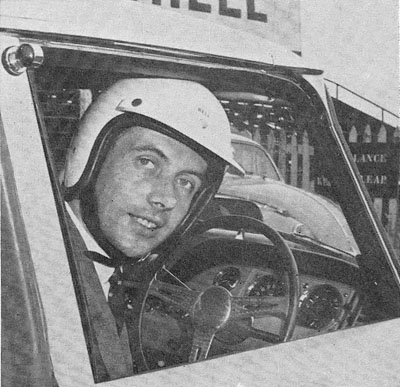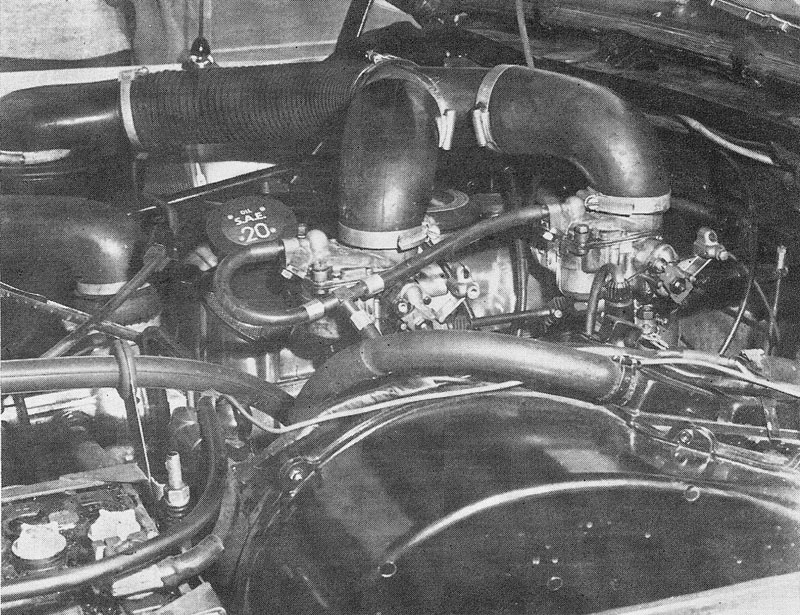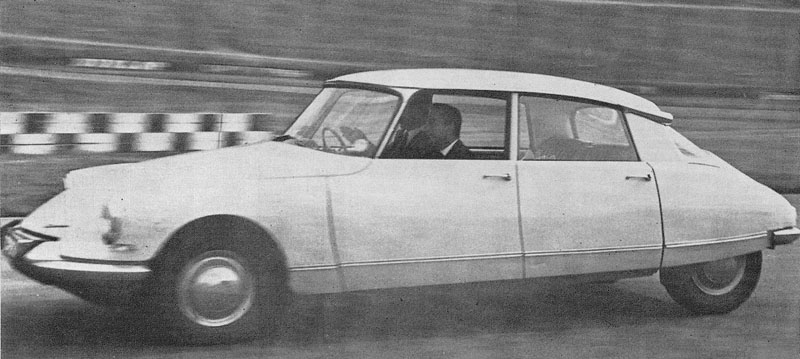|
CITROEN’S
‘SPACE SHIP’ BODY LINES AND INTERIOR have always seemed strangely out
of keeping on a car which relies on a very old-fashioned four-cylinder
two-liter engine. Conversely, what a pity that an otherwise remarkably
advanced motor car should be spoilt by an archaic power unit. It is
probably this clash of ancient and modern which is responsible for
the Citroen ID 19 and DS 19 being overlooked as a high-performance car
— overlooked, that is, until the illusion is killed by a road journey
through France.
There are few cars on Route Nationale 6 more
difficult to pass when they are being driven with anything approaching
enthusiasm, and few capacious sedans as capable of keeping up a ‘sports
car’ average over the twisty stuff. Nevertheless, it has been left to
key French rallymen such as Rene Trantmann, to demonstrate the full
potential of the big Citroens. and to plant in the minds of a handful
of tuners the thought that here is a suitable subject on which to
practice their art.
One of these is a British garage lying
alongside the main London-to-Portsmouth road at Send, in Surrey. It is
a garage from which, a few years ago, the exciting sound and smell of
Grand Prix cars pervaded the atmosphere — the home of the Connaught.
The GP car is no more - a victim of financial strangulation - but
Connaught Cars continues to thrive as, among other things, a Citroen
agency. And one of the ‘specialties of the house,’ to coin a chef's
phrase. is an ameliorated version of the less luxuriously equipped and
lower powered ID 19 and known as the Connaught Citroen GT.
The aim
of Connaught. which is managed by one-time racing driver Alan Brown la
Formula 3 and early Formula 2 star) is to provide, for substantially
the same
price as a DS 19. a car packing more punch and being more attractive to
drive. and lacking only a few of the frills which tend to detract from
performance.
This has been achieved. at a price in Britain of
£1,598 ($4,477). which compares with £1,569 ($4,393) for a new DS 19
and
£1,308 ($3,662) for a new ID 19 in production form.
The
conversion falls into two distinct parts, one aimed at increasing
performance and the other at improving driving comfort and
appreciation. The engine arrangements include fully modifying the
cylinder head, raising the compression ratio from a modest 7.5 to 1 to
8.4 to 1, matching and flowing the inlet and exhaust ports, fitting a
twin-carburetor manifold to take twin SUs or Solexes (as fitted to the
car tested), matching the manifold to the head, fitting heavy-duty valve
springs, a modified thermometer gauge and a different distributor. At
the same time. some 16 pounds weight is skimmed off the flywheel.
Other
GT features are power steering (power brakes have now been standardized
on the ID 19), a ‘Stirling Moss’ wood rim steering wheel, the more
comprehensive DS 19 dashboard. fully reclining Microcell
competition-type front seats, a Kenlowe thermomatic electric cooling
fan, additional body sound proofing, extra stainless steel body rubbing
strips along the sides, retractable reel safety belts and Connaught
body motifs.
The transmission. with its all-synchromesh gearbox
linked to the front wheels and the tremendously effective
hydropneumatic suspension, incorporating a self-levelling device, are
unaltered from standard. The test car was equipped with Michelin ‘X‘
tires.
Like all big Citroens. this is a long-legged car, in fact
the gearing is such that the overdrive top gear can only be used for
effective acceleration above about 50 mph. There is minimal torque at
the bottom of the rev range but against this the lightened flywheel has
not only helped to boost acceleration further up the scale, but also
has speeded up crankshaft deceleration during gear shifts.
In
its modified form the power unit, surprisingly, has not been bench
tested for output figures, but I would estimate its maximum power as
about 90 horsepower at 5,000 to 5.500 rpm. For a long-stroke ‘four’ it
has a remarkable appetite for revs, and can be motored at 6,500 rpm
without coming apart at the seams, not that such high revs are
necessary in building up maximum acceleration.
|

|
|
Although the Citroen is basically an understeering
machine the Connaught GT handles easier due to power-assisted steering.
Our Man in England, John Blunsden (above) has his Bell helmet secured
before taking Connaught GT out at Brands Hatch.
|

|
|
The wood-rimmed wheel is dandy, even with an
unimaginative center.
|

|
|
The 90 horsepower engine uses two Solex carbs,
will accelerate the near ton-and-a-half car to 60 mph in 14.6 seconds,
with a top speed of well over 100 mph. Price is about that of the
DS-19.
|

|
|
In the Connaught
GT version of the ID-19 Citroen, the exterior of the car remains quite
unchanged and extremely functional.
|
|
|
Third gear for the
most part can be used for cruising. Citroen must be one of the very few
two-liter sedans in the world capable of holding over 100 mph in ‘one
below high.’
The steering column gearshift is a good example of
its type. with positive, if quite long shift movements, and a strong
spring protecting reverse. It rests just behind the lightweight
wood-rim wheel. which is a great improvement on that diabolical
one-spoke safety affair they fit on the production model. It has a
thinner and smoother rim and the only jarring note is the completely
uninspired hub design. The DS 19-type instruments are clear to read and
quite well laid out. but surely a rev counter should be standardized on
this car instead of being a listed extra.
The power steering is as
well conceived as any I have tried. There is still some feel from the
front wheel but that arm-wrecking steering of a non-assisted Citroen
has been replaced by a delightfully light and positive control. The car
can be swung from lock to lock in quick succession and despite a
certain amount of body sway, an accurate line can be held without much
trouble. Obviously. the ID 19 is an understeerer, but the power
assistance tends to minimize the effect this at the wheel; in other
words. the driver is encouraged to put on more lock a fraction sooner
than if he had to put a lot of physical effort into it.
Although
in no sense a racing car. I put the Connaught Citroen round Brands
Hatch for a few fastish laps, and was surprised to find that even with
normal tire pressures. it understeered rather less than the average
Mini. and could be cornered extremely fast, even to the extent of
getting the back end moving.
No one who likes to feel his brakes
would happily trade a normal pedal for the button control they provide
on the Citroen. but after a while it becomes apparent that there are,
after all, more than two positions — on and off! But the delicate foot
action. coupled with the inevitable slight time delay of a booster.
means that the disc brakes. although providing adequate stopping power
for the engine performance. are the least attractive mechanical feature.
The
seats give a moderate amount of lateral support and a pleasantly firm
ride with useful behind-the-knees padding. Full ranges of adjustment
allow a very comfortable driving position to be chosen. but this is
then marred by the lack of any space (on right-hand-drive models) for
the left foot alongside the clutch. This criticism would not apply, of
course, on left-hand drive cars.
Noise
level is only a little
higher than normal, and far below the point where it starts to become
obtrusive. For this credit goes to careful body insulation, excellent
aerodynamics, and the use of the thermostatic fan which rarely came
into use during the test. The aerodynamics also must play an important
role in the achievement of such a favorable fuel consumption for a car
of this size and weight. a figure which suggests that a lot of smaller
cars on the roads today are a good deal thirstier than they have any
right to be!
A
car as unorthodox and advanced as the Citroen ID or DS is either liked
or loathed: there are no half-measures. Its fundamental design is such
that it must show up to maximum advantage in its native land, or in
countries like the United States, where an ability for effortless
sustained cruising over surfaces of varying quality is held to be
important. For the more exacting needs of drivers with sporting
instincts, in conditions when good acceleration and ease plus
positiveness of control assume greater significance, Connought's offer
of a ‘GT’ conversion becomes highly attractive.
John Blunsden
|